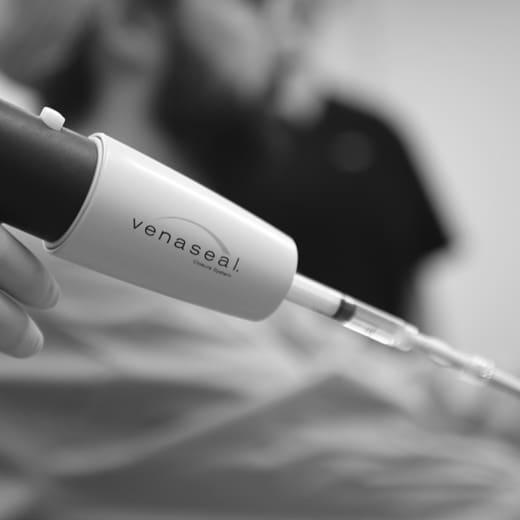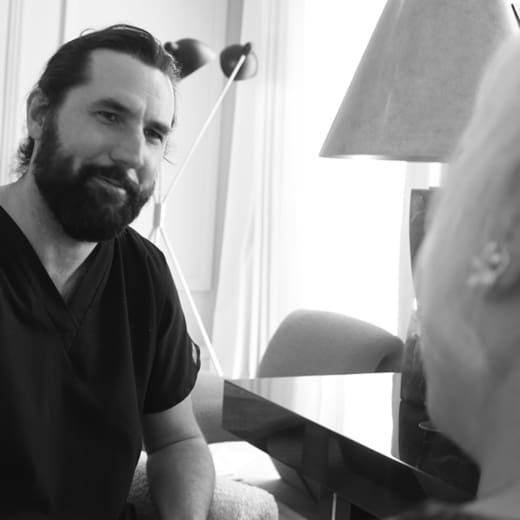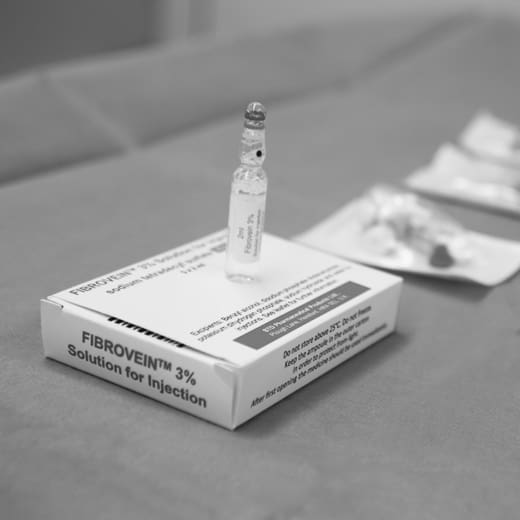McKeown Medical
167 Bath Street, Glasgow, G2 4SQ
Varicose veins are enlarged, twisted veins that often appear just under the skin, primarily in the legs and feet.
Date posted — 7.10.24
Varicose veins are enlarged, twisted veins that often appear just under the skin, primarily in the legs and feet. They can be blue, purple, or flesh-coloured and are often raised, giving a bumpy or rope-like appearance on the skin’s surface. These veins develop when the valves in the veins that regulate blood flow become weakened or damaged, causing blood to pool and the veins to enlarge.
While varicose veins are generally more common in older adults, women, and those with a family history of the condition, factors such as prolonged standing, obesity, and pregnancy can increase the risk.

The symptoms of varicose veins can range from mild to severe. Some people may experience aching, heaviness, or cramping in the legs, particularly after standing or sitting for extended periods. The affected area might also feel itchy or develop a burning sensation.
In more severe cases, varicose veins can lead to swelling, throbbing, and even skin changes, such as discolouration or the development of ulcers near the ankles. The condition is not only a cosmetic concern but can also cause discomfort and, in some cases, lead to more serious circulatory problems.
The best treatment options for varicose veins depend on the severity of the condition, the symptoms experienced and the anatomy of the problematic veins. A detailed clinical review by an expert vascular surgeon, along with a detailed ultrasound scan, will delineate the optimal treatment.
For mild cases, lifestyle changes can be effective in managing symptoms. These include regular exercise to improve circulation, elevating the legs when resting, and wearing compression stockings, which help to reduce swelling and discomfort by improving blood flow in the affected veins. Weight management and avoiding prolonged periods of standing or sitting can also alleviate symptoms and prevent the condition from worsening.
For more severe cases or when lifestyle changes are insufficient, medical treatments may be necessary. Sclerotherapy is a common procedure where a solution is injected into the varicose veins, causing them to collapse and eventually fade. This is most suitable for smaller veins just below the surface of the skin.
The next level of treatment is endovenous treatment, which means operating inside the problematic veins to cause them to collapse. Traditionally, this has been done using either laser or radiofrequency energy to close the affected blood vessels down.
More recently, the VenaSeal™ procedure has been introduced. This is an even less invasive option which uses a special glue to close the veins down.
In cases where these treatments are ineffective or unsuitable, invasive surgical options like vein stripping or phlebectomy may be recommended to remove or tie off the affected veins.
Consulting with an expert vascular surgeon is essential to determine the most appropriate treatment plan based on your individual needs and the severity of your condition.
Dr Alex Vesey is our expert consultant vascular surgeon who heads up our varicose vein team. Listen to him explain your options for varicose vein treatment.

Varicose veins can theoretically happen anywhere on the body but most commonly affect the veins on the legs. Several treatments are available to target and remove varicose veins in the legs specifically.
Endovenous laser treatment (EVLT) and Radiofrequency ablation (RFA) are minimally invasive procedures that remain very popular because they avoid the need for traditional surgery. Both procedures are performed under local anaesthetic and involve inserting a thin tube inside the vein and destroying the vein by delivering heat to close the vein down. Both of these treatments offer a high success rate with less discomfort and scarring than traditional surgery.
The newer VenaSeal™ procedure causes even less discomfort by closing the vein using glue rather than heat. This allows patients an even more rapid return to normal activities without the need to wear compression stockings.
For veins that are not suitable for these treatments, sclerotherapy is a widely used option, especially for smaller varicose veins or spider veins in the legs. During sclerotherapy, a solution is injected directly into the vein, causing it to collapse and gradually be absorbed by the body. Multiple sessions may be required depending on the extent of the varicose veins.
An alternative treatment for smaller veins is a minor surgical procedure called microphlebectomy. This involves making tiny incisions under local anaesthetic to remove problematic veins. While slightly more invasive than sclerotherapy injections, microphlebectomy can be very effective because it physically removes the vessels, which means they cannot come back.
Consulting with an expert vascular surgeon is essential to choosing the most appropriate treatment based on the specific characteristics of the varicose veins in the legs.
Spider veins are small, web-like veins often associated with varicose veins. To treat these, several effective treatment options are available.
Sclerotherapy is the most common and widely used method. In this procedure, a solution is injected directly into the spider veins, causing them to collapse and fade over time. The body gradually absorbs the treated veins, leading to an improved appearance. Sclerotherapy is minimally invasive, typically requires no anaesthetic, and can be done in the outpatient clinic. Multiple sessions may be needed depending on the size and number of spider veins.
Another popular treatment for spider veins is laser therapy. This approach uses focused light energy to target and heat the affected veins, causing them to collapse and eventually disappear. Laser therapy is particularly effective for small, delicate veins that may not be suitable for sclerotherapy. The treatment is non-invasive, and while some patients may experience mild discomfort during the procedure, it generally requires no downtime. In addition to these treatments, maintaining healthy lifestyle habits, such as regular exercise, weight management, and avoiding prolonged periods of standing, can help prevent the development or worsening of spider veins.
If you’d like to find out which varicose veins treatment is the right treatment for you, the first step is to fill out our online consultation form. From there, our team will be able to arrange an initial consultation and ultrasound scan, and we can work together to create a treatment plan that is tailored to your needs.

When it comes to treating varicose veins, VenaSeal™ has emerged as a revolutionary option that offers a minimally invasive and...

Radiofrequency ablation (RFA) and endovenous laser ablation (EVLA) are two minimally invasive treatments used to effectively treat varicose veins, but...

Foam sclerotherapy is an advanced form of sclerotherapy used to treat larger varicose veins, particularly those that may not respond...
1 / 3
2 / 3
3 / 3

When it comes to treating varicose veins, VenaSeal™ has emerged as a revolutionary option that offers a minimally invasive and...

Radiofrequency ablation (RFA) and endovenous laser ablation (EVLA) are two minimally invasive treatments used to effectively treat varicose veins, but...

Foam sclerotherapy is an advanced form of sclerotherapy used to treat larger varicose veins, particularly those that may not respond...
It’s beginning to look a lot like Christmas!
At least according to Michael Buble, who’s been on repeat in the clinic this week. The decorations are up and we are officially in ‘our season’. The clinic has been packed with everyone having their skin polished in time to make it on the nice list. If you’ve still to make a pre-Christmas appointment, we’ve still got some spaces left for your festive glow up.
Ho ho ho everyone… It’s time for Santa!!!! 🎅🏻

Ok, so this is the one we’ve all been waiting for. Sofwave : the results, in our hands!!!
This is the first patient we treated with @sofwave.uk when we were assessing the machine and deciding whether or not to buy it. These are the patient`s own photos that she kept throughout the healing journey.
Now do you see why we are so excited?! 🤩
#sofwave
#sofwavemed
#SUPERB
#sofwavemedical
#sofwavejourney
#sofwaveexperience

We are now well up and running with @sofwave.uk , much to the excitement of the whole team in the clinic (we are all queuing up to get a shot!)
This is a little video of the treatment being performed, so you can see what the process is like and there is even a little early preview of the results at the end.
One of the best parts is that there is no downtime, so we can still fit it in before Christmas without worrying about redness in the party season!
What do you think?
#sofwave
#sofwavemed
#SUPERB
#sofwavemedical
#sofwavejourney
#sofwaveexperience

We`re absolutely delighted to introduce you to our lovely new doctor, Dr Sharon.
With over 30 years’ experience as a medical doctor and a decade specialising in aesthetic medicine, Dr Sharon brings exceptional skill, warmth and a deeply patient-centred approach to every treatment.
She joins us with extensive expertise in injectables, including advanced toxin and filler techniques, and will also be leading our regenerative aesthetics offering with Ameela polynucleotides and Ameela Exosomes - two of the most exciting developments in skin rejuvenation. She will also be offering Profhilo and Profhilo Structura!

We have a super exciting new addition to the clinic this week, with the launch of @sofwavemed.
Sofwave is an incredible skin tightening technology that has been around for five years now. I am never first to the queue with new devices because so many don’t deliver and disappear within a couple of years of launch. Sofwave however has continued to grow in popularity over the years and earlier this year I decided I had to find out what all the fuss was about.
I asked the reps to bring it round for us to play with and we treated a few of our patients to see what the results were like and, three months later not only was I signing the purchase order I was asking how quickly I could get one of the reps round to treat me 😊
Sofwave works using ultrasound waves to create a thermal injury to the deeper layers of the skin, initiating a healing response which over a period of several months results in a skin tightening effect.
I have trialled a number of ultrasound devices in the past and have never bought any of them because I was always disappointed in the results. There are a couple of things that I think makes Sofwave different.
First, it only goes to 1.5mm which means all of the energy is being delivered to the skin. Most other devices go down to 3 or 4mm, by which point you are past the skin and into the fat which can, if anything, have a worsening effect on volume loss. The second difference that I think is important is that it treats a bigger proportion of the surface area of the skin.
We have a new page on our website where you can read all about Sofwave and how it works, but for now, enjoy some of these before and afters that the manufacture supplied.
Let me know what you think!

Lower eyelid surgery is one of the more challenging operations in aesthetic practice. If we can avoid it, we normally try to help our patients chose non-surgical paths using laser or fillers.
However, there are some situations where it can’t be avoided, especially when there is excess fat under the eye causing puffiness. This is exactly what this patient had and so the very talented @bramhallplasticsurgery performed an upper and lower blepharoplasty for him. Whilst we often do the upper eyelids without doing the lower eyelids, usually when we do the lower eyelids we always need to do the uppers too.
This patient is now a couple of months out from surgery and loving his result. What do you think?

Laser season continues!
Thank you to this lovely patient who has kindly allowed us to share her results. She was particularly concerned about the fine lines and creases around her mouth, and underwent full-field laser resurfacing to target the deeper layers of the skin.
This is just two months after treatment and you can already see a significant improvement in the fine lines and overall skin texture. She’s still a little red and got some more healing to do, but she is already very happy with the improvement. This patient was a bit anxious about having the treatment done, so chose to have it under sedation which means she slept throughout and woke up when it was over!
What do you think?

It’s been six months since we launched the new toxin Relfydess in the clinic so, how is it going?
We’ve undertaken a survey of all of the patients we treated with the new toxin in the first month, who are now around six months since their first treatment, to find out more about what they thought of the results over the longer term - whether it kicked in faster, whether it looked better and whether they felt it lasted longer than the previous toxin.
Here are the results, and the feedback so far is really encouraging with the majority of patients reporting that it kicked in faster, looked better and lasted longer.
If you’d like to see more detail and analysis of these results, check out the link to the blog post in our profile.

Aesthetic interventions are never far from the headlines and this week the media have been focused on comments made by the make up artist Bobbi Brown about her view of cosmetic procedures. I was on BBC Radio Scotland today talking about the issue.
My own view is that we should all age in the way we feel comfortable with - if you are happy with grey hair and wrinkles, then I absolutely admire you just as much as I admire those who feel differently and want a little help to keep the signs of ageing at bay. There is no right and wrong and there is no room for moral superiority. Just you be you!
Have a listen to the debate and let me know what you think in the comments!
